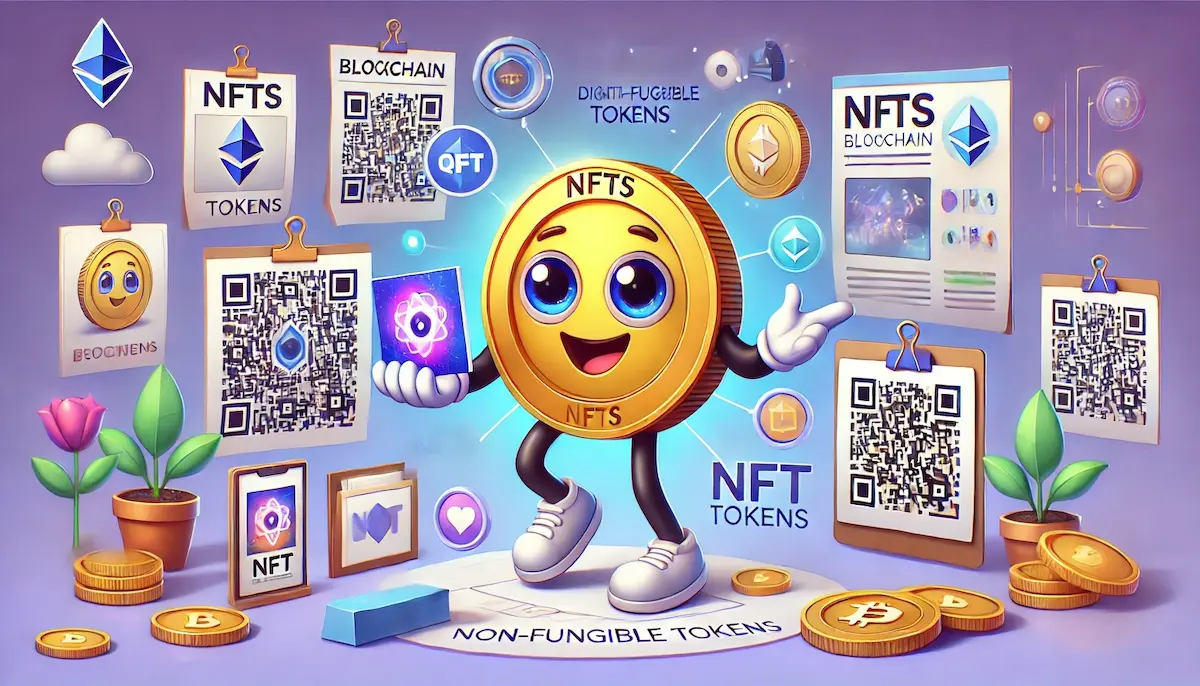Non-Fungible Tokens (NFTs) are unique digital assets that represent ownership or proof of authenticity of a specific item or piece of content, stored on a blockchain. Unlike cryptocurrencies like Bitcoin or Ethereum, which are fungible and can be exchanged on a one-to-one basis, NFTs are indivisible and unique. This distinctiveness makes NFTs ideal for representing ownership of digital art, collectibles, music, videos, and even virtual real estate.
How NFTs Work
NFTs operate on blockchain technology, most commonly on the Ethereum blockchain using the ERC-721 and ERC-1155 standards. Here’s a simplified process of how they work:
- Creation: A digital asset is created or “minted” as an NFT. This process involves encoding the asset’s information and metadata onto the blockchain, ensuring its uniqueness and authenticity.
- Ownership: Once minted, the NFT is assigned to an owner, recorded on the blockchain. The ownership can be transferred, but the original NFT remains unique and traceable.
- Marketplaces: NFTs are bought and sold on specialized marketplaces like OpenSea, Rarible, and Foundation. Transactions are conducted using cryptocurrencies, primarily Ethereum.
- Smart Contracts: NFTs utilize smart contracts to enforce specific rules, such as royalties for creators on secondary sales, ensuring artists continue to benefit from their work.
Characteristics of NFTs
Uniqueness
Each NFT has unique information and attributes, making it distinct from other tokens. This uniqueness is secured by the blockchain, which verifies and records the NFT’s authenticity and ownership.
Indivisibility
NFTs cannot be divided into smaller units like cryptocurrencies. They exist as whole items, ensuring that ownership and value are not fragmented.
Ownership
NFTs provide verifiable proof of ownership. The blockchain records every transaction and transfer, creating a transparent and immutable ownership history.
Interoperability
NFTs can be used across different platforms and applications. For example, an NFT representing a piece of virtual real estate can be used in various virtual worlds or games.
Applications of NFTs
Digital Art
NFTs have revolutionized the digital art world by enabling artists to tokenize their work. Platforms like SuperRare and Nifty Gateway allow artists to sell their digital creations directly to collectors, often for significant sums. NFTs also ensure artists receive royalties from secondary sales.
Collectibles
Digital collectibles, such as virtual trading cards and in-game items, are popular applications of NFTs. Examples include CryptoKitties, where users can buy, sell, and breed unique digital cats, and NBA Top Shot, which allows users to own officially licensed NBA highlight clips.
Music and Entertainment
Musicians and entertainers use NFTs to monetize their work directly. Artists can release exclusive albums, concert tickets, and behind-the-scenes content as NFTs. For instance, Kings of Leon released their album “When You See Yourself” as an NFT, offering exclusive perks to buyers.
Virtual Real Estate
NFTs enable the ownership and trading of virtual real estate in virtual worlds like Decentraland and The Sandbox. Users can buy, sell, and develop virtual land, creating unique experiences and communities within these digital spaces.
Domain Names
Blockchain-based domain names, such as those provided by Unstoppable Domains, are another application of NFTs. These domain names are unique and can be bought, sold, and transferred like other NFTs, offering a decentralized alternative to traditional domain registries.
Challenges of NFTs
Environmental Impact
The blockchain networks that NFTs rely on, particularly Ethereum, require significant computational power, leading to high energy consumption and environmental concerns. Efforts are being made to transition to more eco-friendly blockchain technologies.
Market Volatility
The NFT market is highly speculative and volatile. Prices for NFTs can fluctuate dramatically, leading to potential financial risk for buyers and sellers.
Intellectual Property Issues
Determining the rightful ownership and authenticity of digital content can be challenging. Cases of copyright infringement and unauthorized minting of NFTs have raised concerns about intellectual property rights.
Accessibility and Usability
The process of buying, selling, and creating NFTs can be complex and intimidating for newcomers. User-friendly platforms and educational resources are needed to make NFTs more accessible to a broader audience.
The Future of NFTs
The future of NFTs is promising, with potential expansions into various sectors beyond art and collectibles. Innovations in blockchain technology, such as Ethereum’s transition to a proof-of-stake consensus mechanism, aim to address environmental concerns and scalability issues. As legal frameworks and market practices evolve, NFTs are expected to become a standard for digital ownership and asset management, unlocking new opportunities in the digital economy.
Blockfine thanks you for reading and hopes you found this article helpful.
